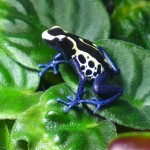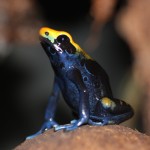



Back to the main dart frog page
Dendrobates tinctorius populations
Dendrobates tinctorius is a polymorphic species that ranges across Suriname, Brazil, French Guiana, and Guyana. Often you will see particular morphs described within the dendrobatid hobby as:
- Dendrobates tinctorius ‘Azureus’ (reference to the original species name and its blue color)
- Dendrobates tinctorius ‘Bakhuis’ (named after the collection location)
- Dendrobates tinctorius ‘True Sipaliwini’ (named after the collection location)
- Dendrobates tinctorius ‘Patricia’ (named after the collectors wife)
In some cases specific locale data is offered with an import, while in others general regional data is provided. The hobby uses these names to distinguish between different tinctorious morphs which allows us to maintain representative phenotypes from the different populations that have been imported over the years. Our objective is to maintain a healthy captive population that closely resembles their wild counterparts.
These population identifiers have been curated in the hobby for decades. Periodically a hobbyist or breeder decides to hybridize animals from different locales to create a different color pattern. Be careful when purchasing hybrids – they may make a fine pet for you, but if you intend to participate in the hobby more seriously, avoid animals of suspect origin. This is akin to purchasing animals from the “mixed African cichlids” tanks at large scale pet shops. You cannot visually sort animals and link them back to a population, so take care in selecting a breeder when making a purchase. Also note these animals can live for 25+ years. Based on typical hobby patterns, most people leave the hobby after 1 to 2 years, so you will likely have to re-home your animal. Purchasing hybrids will make rehoming far more difficult. This page describes tinctorious collection points, coloration and size variance in more detail.
Known tinctorius morphs & locales
The generally referenced range for Dendrobates tinctorius has been published by IUCN here. The map detailing the range:

There are over 45 known tinctorius morphs that vary by size and color depending on their collection point. Martin Haberkern maintains the most comprehensive morph guide I have found. Using this morph guide augmented with other sources of population data, I have built out an interactive Dendrobates tinctorius locale map.
Many of these locales are estimates based on somewhat vague descriptions provided by the importers. Here is the current map I have developed, pulling known locality data from a variety of sources:
The area calculation yields a value of roughly 520,000 square kilometers, which is roughly 200,000 square miles. To put this in perspective, the D. tinctorius range is:
- larger than the state of California (156,000 sq mi)
- smaller than Texas (262,000 sq mi)
- about the size of Spain (506,000 sq km)
- slightly smaller than France (550,000 sq km)
- slightly larger than Sweden (450,000 sq km)
So we have a geograhic distribution roughly equivalent to an area the size of California, with multiple rivers cutting through the region, as well as savannas and island forests, that separate a variety of D. tinctorius morphs from each other. These D. tinctorius populations vary in size from 25 mm to 75 mm, depending on their collection point. Their colors vary widely, again depending on the collection point. The photos I presented at the top of this page are examples of the extreme variability you will see across their range.




- Dendrobates tinctorius ‘Bakhuis’ is a dwarf population from the Bakhuis Mountains in western Suriname. They reach a maximum SVL of about 35 mm.
- Dendrobates tinctorius ‘Lorenzo’ is another dwarf population purportedly from northeastern Brazil in Sao Lorenco in the State of Amapa. This is a black bodied morph with dark blue reticulation and a yellow crest (larger on males than females). Their max SVL is also in the 35 mm range.
- Dendrobates tinctorius ‘Azureus’ is one of the more famous populations. It is a medium sized population reaching 50 mm SVL from the Sipaliwini Savannah in southern Suriname. They are limited to a series of island forests within the Savannah. Their base blue coloration is broken by a highly variable pattern of black dots – coverage varies widely from animal to animal.
- Dendrobates tinctorius ‘Robertus’ is a large bodied population from southern Suriname, achieving a max SVL of 60 mm. This is a highly variable population, ranging from solid blue animals to “high yellow”. Most animals in the hobby are characterized by yellow heads and yellow bellies.
This is a sampling of the variability of sizes and colors of just 4 of the 45+ known populations. There are many theories on what drives this variability, which I’ll cover in the next section.
Scientific literature
http://bnoonan.org/Papers/Wollenberg_et_al_06.pdf
Hybrids and hybridization
You may encounter animals that have been intentionally crossed, mistakenly crossed, or you just may not know. Unless the breeder you are working with has maintained records of the source of their animals and how they have paired their breeding pairs or groups, you cannot trace the lineage of your animals.
If you intend to breed and pass offspring on to other keepers, you have to be aware of your lineages and pass them along with your frogs.
If you are just keeping a frog for fun (and you realize your frog may live for 25+ years) then buy from the “mixed” tank. Realize though, a hybrid is not “worth” as much as an animal with lineage data. You should not be paying more than $10 for this animal, as you will be housing it for it’s lifespan, and you will have little recourse for rehoming, as you will not be able to resell it within the existing hobby without lineage data.

